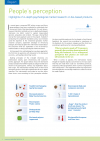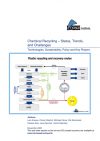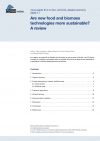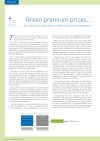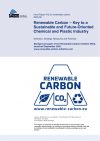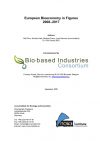Showing 141–160 of 424
-
Bio-based Naphtha and Mass Balance Approach – Status & Outlook, Standards & Certification Schemes – Short Version
Markets & Economy
6 Pages
901 Downloads
901 Downloads
2021-03
FREE
Free Shipping901
DownloadsNew report on alternative, non-fossil naphtha with the first comprehensive overview of technology, producers, plants and users
Bio-based naphtha has been available on the market for a few years now. In Europe, about 150,000 tonnes are already used annually, mainly for polymer production. As soon as the political-economic framework conditions are right, this number could quickly increase to several million tonnes, which have flowed into the HVO (hydrotreated or hydrogenated vegetable oils) biodiesel market so far. These fuels differ only slightly from fossil-based naphtha in their chemical composition. The report presents 17 companies worldwide with capacities ranging from a few thousand tonnes per year to 3 million tonnes. There are currently plans for 50 new or expanded plants.
-
Bio-based Naphtha and Mass Balance Approach – Status & Outlook, Standards & Certification Schemes
Markets & Economy
48 Pages

2021-03
850 € – 3,500 €Price range: 850 € through 3,500 € ex. tax
Plus 19% MwSt.Free ShippingPress
release Select
licenceNew report on alternative, non-fossil naphtha with the first comprehensive overview of technology, producers, plants and users
Bio-based naphtha has been available on the market for a few years now. In Europe, about 150,000 tonnes are already used annually, mainly for polymer production. As soon as the political-economic framework conditions are right, this number could quickly increase to several million tonnes, which have flowed into the HVO (hydrotreated or hydrogenated vegetable oils) biodiesel market so far. These fuels differ only slightly from fossil-based naphtha in their chemical composition. The report presents 17 companies worldwide with capacities ranging from a few thousand tonnes per year to 3 million tonnes. There are currently plans for 50 new or expanded plants.
-
2nd International Conference on Cellulose Fibres Proceedings 2021
Markets & Economy, Policy, Sustainability & Health, Technology
102 Downloads
102 Downloads
2021-02
FREE
Plus 19% MwSt.Free Shipping102
DownloadsThe proceedings of the 2nd International Conference on Cellulose Fibres (2-3 February 2021, https://cellulose-fibres.eu) contain 26 presentations, the conference journal, and the press release of the three winners of the Cellulose Fibre Innovation of the Year 2021 Award!
-
193 Downloads
2021-02
FREE
193
DownloadsIn einem komplementären Ansatz liefert chemisches Recycling zusätzliche Optionen, die das derzeitige Recyclingsystem verbessern und erweitern können.
-
Carbon economy – Studies on support to research and innovation policy in the area of bio-based products and services
Markets & Economy, Policy, Sustainability & Health, Technology
384 Pages
650 Downloads
650 Downloads
2021-02
FREE
Free Shipping650
DownloadsNova-Institute, together with COWI and Utrecht University published a report on the role of carbon in the global, European and regional economy for the Directorate-General for Research and Innovation (European Commission).
The report herein contains five Work Packages (WPs) that embody the requirements set out in the European Commission’s “Studies on support to R&I policy in the area of bio-based products and services – Carbon Economy (Lot 1).” The main aim of the project was to map out the current pathways available for the transition towards a low carbon economy as well as the barriers that hinder this transition. Based on the conclusions and key findings from the WPs, the authors set the scene for the future of the bio-based sector with a particular focus on ten case studies of regions and cities across the EU (WP4), an evaluation of promising innovations and novel technologies for the realisation of such an economy and a sweeping regulatory analysis containing Q1 2020 updates (WP3) on EU directives and regulations that pertain to the low carbon economy. This attention to the local level as well as the broader policy sphere is supported by a scientific understanding of the low carbon economy (WP1), potential future scenarios towards 2050 (WP2) as well as clear dissemination of the findings across the entire study (WP5). In the frame of the study an animated educational video was produced. The final study report contains an executive summary followed by each Work Package in its entirety, which can also be treated as stand-alone reports in their own right.
Further information at: https://op.europa.eu/en/publication-detail/-/publication/8c4de15d-a17d-11eb-b85c-01aa75ed71a1
-
Bio-based Building Blocks and Polymers – Global Capacities, Production and Trends 2020 – 2025
Markets & Economy
338 Pages

2021-01
100 € – 500 €Price range: 100 € through 500 € ex. tax
Plus 19% MwSt.Press
release Select
licenceReport on the global bio-based polymer market 2020 – A deep and comprehensive insight into this dynamic market
The year 2020 was a promising year for bio-based polymers: Sold out PLA in 2019 has led to the installation of increased capacities, PE and PP made from bio-based naphtha are breaking ground and future expansion for bio-based polyamides as well as for PBAT, PHAs and casein polymers is on the horizon. A lower production is only observed for bio-based PET.
-
Carbon dioxide (CO2) as chemical feedstock for polymers – technologies, polymers, developers and producers − Short Version
Markets & Economy
12 Pages
2378 Downloads
2378 Downloads
2021-01
FREE
Plus 19% MwSt.2378
DownloadsCompletely revised and extended third version of nova’s technology and trend report “Carbon Dioxide (CO2) as Chemical Feedstock for Polymers – Technologies, Polymers, Developers and Producers” available
The nova report addresses the polymer industry, brands, technology scouts, investors, and policy makers. The report provides 100 pages of information around CO2 utilisation for chemical building blocks and polymers.
-
Bio-based Building Blocks and Polymers – Global Capacities, Production and Trends 2020 – 2025 – Short Version
Markets & Economy
16 Pages
2951 Downloads
2951 Downloads
2021-01
FREE
Plus 19% MwSt.2951
DownloadsReport on the global bio-based polymer market 2020 – A deep and comprehensive insight into this dynamic market
The year 2020 was a promising year for bio-based polymers: Sold out PLA in 2019 has led to the installation of increased capacities, PE and PP made from bio-based naphtha are breaking ground and future expansion for bio-based polyamides as well as for PBAT, PHAs and casein polymers is on the horizon. A lower production is only observed for bio-based PET.
-
Carbon dioxide (CO2) as chemical feedstock for polymers – technologies, polymers, developers and producers
Markets & Economy
100 Pages

2021-01
500 € – 1,000 €Price range: 500 € through 1,000 € ex. tax
Plus 19% MwSt.Press
release Select
licenceCompletely revised and extended third version of nova’s technology and trend report “Carbon Dioxide (CO2) as Chemical Feedstock for Polymers – Technologies, Polymers, Developers and Producers” available
The nova report addresses the polymer industry, brands, technology scouts, investors, and policy makers. The report provides 100 pages of information around CO2 utilisation for chemical building blocks and polymers.
-
Production of Cannabinoids via Extraction, Chemical Synthesis and Especially Biotechnology – Preview
Markets & Economy, Sustainability & Health
8 Pages
347 Downloads
347 Downloads
2021-01
FREE
Plus 19% MwSt.347
DownloadsHuge market potential for CBD and other cannabinoids – how best to produce them?
Cannabis removed from the UN prohibition schedule and CBD not considered as a narcotic drug – Two major decisions to drive further research to explore the full potential of one of the major and longest established medicinal plants
The new report “Production of Cannabinoids via Extraction, Chemical Synthesis and Especially Biotechnology – Current Technologies, Potential & Drawbacks and Future Development” provides all information on production technologies, medical applications and political framework conditions. The Report will guide you through the complex synthesis of cannabinoids, state-of-the-art methods for extraction and production and will extensively show the major hidden potential and synergistic effects of biotechnological cannabinoid production. The report is aimed at experts in the pharmaceutical and biotech industry and provides deep insights into (bio)chemical reactions, processes and producers. The main authors are biotechnology experts and physicians from the nova-Institute, Dr. Pia Skoczinski and Dr. med. Franjo Grotenhermen, and the chemist Dr. rer. nat. Bernhard Beitzke, who has been advising the “European Industrial Hemp Association” (EIHA) as an expert for years. The 142-page technology report provides in-depth information on established and emerging biotechnological approaches on the production of cannabinoids, as well as an overview on the state-of-the-art production methods using plant extraction and chemical synthesis. An extensive description of pharmacological effects, therapeutic potential and medicinal applications for ∆9-tetrahydrocannabinol (∆9-THC) and cannabidiol (CBD), together with a short excursus on the EU regulatory framework for cannabinoids, conclude this comprehensive study. Additionally, 59 companies active in cannabinoid production are listed, from which 20 specialised in biotechnological production and chemical synthesis are described in detail.
-
Production of Cannabinoids via Extraction, Chemical Synthesis and Especially Biotechnology
Markets & Economy, Sustainability & Health
148 Pages

2021-01
2,000 € – 10,000 €Price range: 2,000 € through 10,000 € ex. tax
Plus 19% MwSt.Press
release Select
licenceHuge market potential for CBD and other cannabinoids – how best to produce them?
Cannabis removed from the UN prohibition schedule and CBD not considered as a narcotic drug – Two major decisions to drive further research to explore the full potential of one of the major and longest established medicinal plants
The new report “Production of Cannabinoids via Extraction, Chemical Synthesis and Especially Biotechnology – Current Technologies, Potential & Drawbacks and Future Development” provides all information on production technologies, medical applications and political framework conditions. The Report will guide you through the complex synthesis of cannabinoids, state-of-the-art methods for extraction and production and will extensively show the major hidden potential and synergistic effects of biotechnological cannabinoid production. The report is aimed at experts in the pharmaceutical and biotech industry and provides deep insights into (bio)chemical reactions, processes and producers. The main authors are biotechnology experts and physicians from the nova-Institute, Dr. Pia Skoczinski and Dr. med. Franjo Grotenhermen, and the chemist Dr. rer. nat. Bernhard Beitzke, who has been advising the “European Industrial Hemp Association” (EIHA) as an expert for years. The 142-page technology report provides in-depth information on established and emerging biotechnological approaches on the production of cannabinoids, as well as an overview on the state-of-the-art production methods using plant extraction and chemical synthesis. An extensive description of pharmacological effects, therapeutic potential and medicinal applications for ∆9-tetrahydrocannabinol (∆9-THC) and cannabidiol (CBD), together with a short excursus on the EU regulatory framework for cannabinoids, conclude this comprehensive study. Additionally, 59 companies active in cannabinoid production are listed, from which 20 specialised in biotechnological production and chemical synthesis are described in detail.
-
nova-paper #13: Bio-based products: Green premium prices and consumer perception of different biomass feedstocks
Markets & Economy
30 Pages
2073 Downloads
2073 Downloads
2020-12
FREE
Plus 19% MwSt.2073
Downloads -
Highlights of in-depth psychological market research on bio-based products
Markets & Economy
192 Downloads
192 Downloads
2020-11
FREE
Free Shipping192
DownloadsIn recent years, numerous B2C online surveys and focus group analyses have been conducted to understand what consumers think of bio-based products. It is well known, however, that other methods such as in-depth psychological interviews are better suited to explore deep-seated opinions, prejudices and contexts. This gap is being filled now by the novel approach used in this project. Instead of conducting the umpteenth standard survey, nova-Institute used the expertise of the renowned specialist market research company september Strategie & Forschung (Cologne, Germany) to gather the information needed about the consumer mind set. september is one of Germany’s market leaders in deep psychological market research.
-
Chemical Recycling – Status, Trends and Challenges. Technologies, Sustainability. Policy and Key Players
Markets & Economy, Technology
190 Pages

2020-11
500 € – 1,500 €Price range: 500 € through 1,500 € ex. tax
Plus 19% MwSt.Press
release Select
licenceNew market and technology report: Chemical Recycling – Status, Trends, and Challenges – Technologies, Sustainability, Policy and Key Players
nova’s new market and technology report „Chemical Recycling – Status, Trends, and Challenges” is addressed to the chemical and plastic industry, brands, technology scouts, investors, and policy makers. On 190 pages the report provides information around chemical recycling including 21 figures and 10 tables.
The report provides deep insights into current developments in order to assert a position in the current discussion based on clear definitions and categorisations of all technologies. More than 70 companies and research institutes, which developed and offer chemical recycling technologies, are presented in the report. Each company is listed with its technologies and status, investment and cooperation partners. Additionally, the report provides an overview of waste policy in the European Union. And finally, 10 companies and research institutes were interviewed to receive first-hand information around the topic of chemical recycling.
Further information:
The old report “Chemical Recycling – Status, Trends and Challenges” differs from the new report “Mapping of advanced recycling – Providers, technologies, and partnerships” as follows:
- >70 technologies and providers (vs. >100 technologies and providers in the new report)
- Profiles only with updated information of 2020
- The extensive introductory part on polymer types, demand of different polymer types, waste fractions, political framework, position papers, technologies, LCAs, associations and waste management companies are included in this report
In summary, this report is suitable for interested readers who have not yet dealt with advanced recycling and are searching for a introduction into the topic while an up-to-date overview of all identified providers is less important.
P.S.: All you want to know about advanced recycling technologies and renewable chemicals, building-blocks, monomers, and polymers based on recycling: Hear about it at the Advanced Recycling Conference (ARC), 28–29 November 2023, Cologne, Germany (hybrid event).
-
Chemical Recycling – Status, Trends and Challenges. Technologies, Sustainability, Policy and Key Players − Short Version
Markets & Economy, Technology
10 Pages
1992 Downloads
1992 Downloads
2020-11
FREE
1992
DownloadsNew market and technology report: Chemical Recycling – Status, Trends, and Challenges – Technologies, Sustainability, Policy and Key Players
nova’s new market and technology report „Chemical Recycling – Status, Trends, and Challenges” is addressed to the chemical and plastic industry, brands, technology scouts, investors, and policy makers. On 190 pages the report provides information around chemical recycling including 21 figures and 10 tables.
The report provides deep insights into current developments in order to assert a position in the current discussion based on clear definitions and categorisations of all technologies. More than 70 companies and research institutes, which developed and offer chemical recycling technologies, are presented in the report. Each company is listed with its technologies and status, investment and cooperation partners. Additionally, the report provides an overview of waste policy in the European Union. And finally, 10 companies and research institutes were interviewed to receive first-hand information around the topic of chemical recycling.
-
nova-Paper #14: Are new food and biomass technologies more sustainable? A review − Full version
Sustainability & Health
22 Pages
631 Downloads
631 Downloads
2020-11
FREE
631
Downloads -
nova-paper #13: Bio-based products: Green premium prices and consumer perception of different biomass feedstocks − Article in bioplastics MAGAZINE
Markets & Economy
2 Pages
496 Downloads
496 Downloads
2020-10
FREE
496
Downloads -
nova-Paper #12: Renewable Carbon – Key to a Sustainable and Future-oriented Chemical and Plastic Industry − Full version
Policy
25 Pages
4959 Downloads
4959 Downloads
2020-09
FREE
4959
Downloads -
541 Downloads
2020-09
FREE
541
Downloads -
188 Downloads
2020-09
FREE
188
Downloads


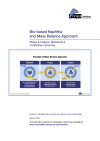
![2nd International Conference on Cellulose Fibres Proceedings 2021 [Digital]](https://renewable-carbon.eu/publications/wp-content/uploads/2020/05/21-01-07_RC-Publications-Cover-Proceedings_Cellulose-Fibres-100x141.png)
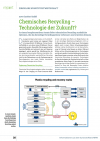
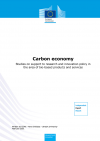
![Bio-based Building Blocks and Polymers – Global Capacities, Production and Trends 2020 – 2025 [Digital]](https://renewable-carbon.eu/publications/wp-content/uploads/2021/01/Bio-based-building-blocks-2025-100x141.png)
![Carbon dioxide (CO2) as chemical feedstock for polymers – technologies, polymers, developers and producers − Short Version [Digital]](https://renewable-carbon.eu/publications/wp-content/uploads/2021/01/TRCCU-1-100x141.png)
![Production of Cannabinoids via Extraction, Chemical Synthesis and Especially Biotechnology - Preview [Digital]](https://renewable-carbon.eu/publications/wp-content/uploads/2021/01/Cannabinoids-100x141.png)
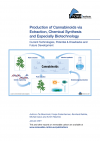
![nova-paper #13: Bio-based products: Green premium prices and consumer perception of different biomass feedstocks [Digital]](https://renewable-carbon.eu/publications/wp-content/uploads/2020/12/novapaper13-100x141.png)
